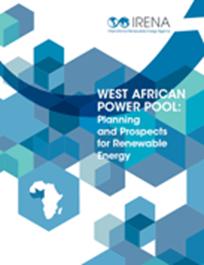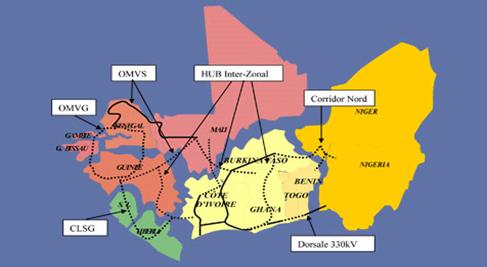West African Power Pool: Planning and Prospects for Renewable Energy
By
International Renewable Energy Agency, June 2013 www. irena.org
 With the energy systems of many
African countries dominated by fossil-fuel sources that are vulnerable to
global price volatility, regional and intra-continental power systems with
high shares of renewable energy can provide least-cost option to support continued
economic growth and address the continent’s acute energy access problem.
Unlocking Africa’s huge renewable energy potential could help to take many
people out of poverty, while ensuring the uptake of sustainable technologies
for the continent’s long-term development.
With the energy systems of many
African countries dominated by fossil-fuel sources that are vulnerable to
global price volatility, regional and intra-continental power systems with
high shares of renewable energy can provide least-cost option to support continued
economic growth and address the continent’s acute energy access problem.
Unlocking Africa’s huge renewable energy potential could help to take many
people out of poverty, while ensuring the uptake of sustainable technologies
for the continent’s long-term development.
 IRENA’s
report, West African Power Pool: Planning and Prospects for Renewable Energy,
examines a “renewable scenario” based on a modeling tool developed by IRENA and
tested with assistance from the Economic Community of West African States
(ECOWAS). Initial results from the ECOWAS Renewable Energy Planning (EREP)
model for continental ECOWAS countries show that the share of renewable
technologies in the region could increase from the current 22% of electricity
generation to as much as 52% in 2030, provided that the cost of these
technologies continues to fall and fossil fuel prices continue to rise. In this
scenario, nearly half of the envisaged capacity additions between 2010 and 2030
would be with renewable technologies.
IRENA’s
report, West African Power Pool: Planning and Prospects for Renewable Energy,
examines a “renewable scenario” based on a modeling tool developed by IRENA and
tested with assistance from the Economic Community of West African States
(ECOWAS). Initial results from the ECOWAS Renewable Energy Planning (EREP)
model for continental ECOWAS countries show that the share of renewable
technologies in the region could increase from the current 22% of electricity
generation to as much as 52% in 2030, provided that the cost of these
technologies continues to fall and fossil fuel prices continue to rise. In this
scenario, nearly half of the envisaged capacity additions between 2010 and 2030
would be with renewable technologies.
Analysis using EREP – along with a
similar model developed for Southern Africa – can provide valuable input for
regional dialogue and energy projects such as the East and Southern Africa
Clean Energy Corridor and the Program for Infrastructure and Development in
Africa (PIDA). IRENA, together with partner organizations, has started plans to
set up capacity building and development support for energy system modeling and
planning for greater integration of renewables in Africa. IRENA is also
completing a similar model and study for East Africa and intends to extend this
work to Central and North Africa.
 For the link to full report:
For the link to full report:
http://www.irena.org/menu/index.aspx?mnu=Subcat&PriMenuID=36&CatID=141&SubcatID=333

 With the energy systems of many
African countries dominated by fossil-fuel sources that are vulnerable to
global price volatility, regional and intra-continental power systems with
high shares of renewable energy can provide least-cost option to support continued
economic growth and address the continent’s acute energy access problem.
Unlocking Africa’s huge renewable energy potential could help to take many
people out of poverty, while ensuring the uptake of sustainable technologies
for the continent’s long-term development.
With the energy systems of many
African countries dominated by fossil-fuel sources that are vulnerable to
global price volatility, regional and intra-continental power systems with
high shares of renewable energy can provide least-cost option to support continued
economic growth and address the continent’s acute energy access problem.
Unlocking Africa’s huge renewable energy potential could help to take many
people out of poverty, while ensuring the uptake of sustainable technologies
for the continent’s long-term development. IRENA’s
report, West African Power Pool: Planning and Prospects for Renewable Energy,
examines a “renewable scenario” based on a modeling tool developed by IRENA and
tested with assistance from the Economic Community of West African States
(ECOWAS). Initial results from the ECOWAS Renewable Energy Planning (EREP)
model for continental ECOWAS countries show that the share of renewable
technologies in the region could increase from the current 22% of electricity
generation to as much as 52% in 2030, provided that the cost of these
technologies continues to fall and fossil fuel prices continue to rise. In this
scenario, nearly half of the envisaged capacity additions between 2010 and 2030
would be with renewable technologies.
IRENA’s
report, West African Power Pool: Planning and Prospects for Renewable Energy,
examines a “renewable scenario” based on a modeling tool developed by IRENA and
tested with assistance from the Economic Community of West African States
(ECOWAS). Initial results from the ECOWAS Renewable Energy Planning (EREP)
model for continental ECOWAS countries show that the share of renewable
technologies in the region could increase from the current 22% of electricity
generation to as much as 52% in 2030, provided that the cost of these
technologies continues to fall and fossil fuel prices continue to rise. In this
scenario, nearly half of the envisaged capacity additions between 2010 and 2030
would be with renewable technologies. For the link to full report:
For the link to full report: